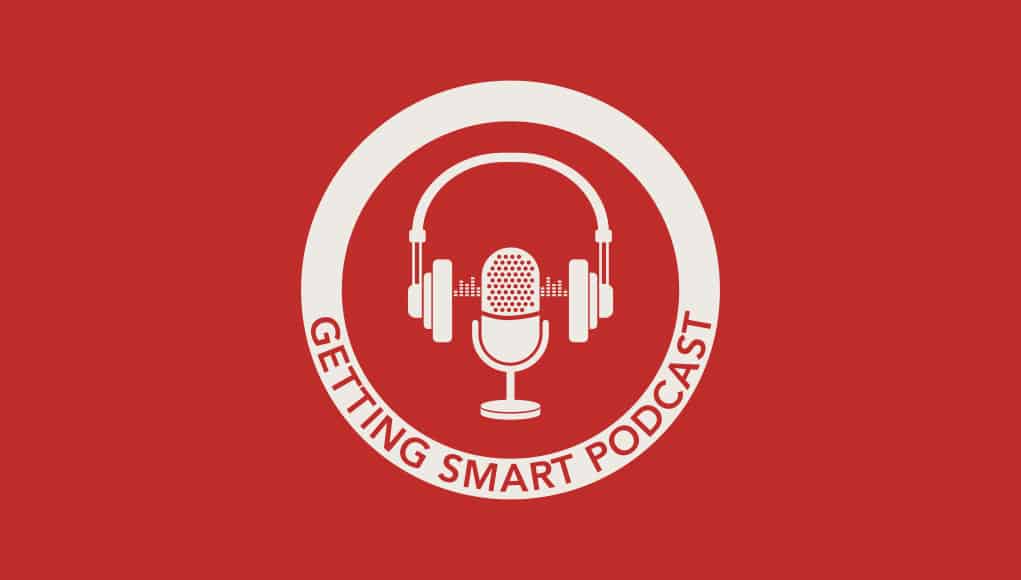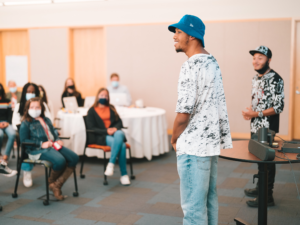Getting Smart Podcast | Design Thinking as Pedagogy For Students and Educators

“Design thinking is a human-centered approach to innovation that draws from the designer’s toolkit to integrate the needs of people, the possibilities of technology, and the requirements for business success.” —Tim Brown, president and CEO, IDEO
As mindset and toolset, as pedagogy and professional learning, as improvement and innovation framework, design thinking has come center stage in U.S. K-12 education.
Sandy Speicher (@sandyspeicher) has a lot to do with this new edu-meme. She leads the education team at IDEO, a San Francisco-based design shop.
“Design thinking is a human-centered approach to problem-solving,” said Speicher. “It reflects how designers think and act–both mindset and tools,” added Speicher. “It’s solving problems to make the world better.”
Here’s more from a recent conversation Sandy and I had around design thinking and how important it is in education right now:
Design thinking was discussed in science, engineering and architecture in the 70’s and 80’s. David Kelly, co-founder of IDEO, began applying it to business in the 90s along with the rise of business process reengineering (advocated by Michael Hammer) and systems thinking (advanced by Peter Senge).
Like the scientific method, design thinking can be applied to a broad set of opportunities and challenges. Through an iterative process, design thinking seeks solutions that are desirable, viable and feasible.

IDEO built the educator toolkit in a professional learning network called the Teachers Guild. Teachers share solutions and strategies.


Design thinking is as important students as it is for teachers according to Speicher. (We agree and think the best prep for life with smart machines is using design thinking to navigate novelty and complexity.)
We’ve found evidence of design thinking in SPARK elementary schools in South Africa and at innovative high schools including High Tech High in San Diego and One Stone in Boise. In higher education, the best example of design thinking is Olin College near Boston.
After observing students exercising design thinking in Ahmedabad, India, Sandy said, “It’s unbelievable what kids see and want to solve.”
Design Thinking For EdLeaders
Design thinking raises new issues and opportunities for school and system leaders.
A new divide we should worry about, according to Speicher, is youth equipped with design skills and those that don’t. Understanding stakeholders and exercising continuous problem solving are “essential skills in this world,” said Speicher.
With all the focus on standards master, it has been hard to find time for inquiry-based learning. Sandy said, “We shouldn’t shy away from that tension.” She added, “We know character strengths, mindsets and dispositions are important,” and deeper learning activities including design thinking investigations are a great way to develop these new priority outcomes
With support from the Stanford d.school and Hewlett Foundation, IDEO developed School Retool, a toolkit and fellowship for EdLeaders that redesign school culture using small experiments called “hacks.” These hacks may start small, but are designed to lead to deeper learning, and can create the kind of big change you aspire to—namely, preparing your students for life in the real world.
Through this year’s recent Shadow a Student Challenge, IDEO encouraged EdLeaders to follow a student around for a day to better appreciate the learner experience.
For more, see:
- Stanford CTO Provokes Good Questions Online (and Off)
- Big Picture Learning in the Real World
- Design Thinking: A Human-Centered Approach to Innovation in Education
Stay in-the-know with all things EdTech and innovations in learning by signing up to receive the weekly Smart Update. This post includes mentions of a Getting Smart partner. For a full list of partners, affiliate organizations and all other disclosures please see our Partner page.







0 Comments
Leave a Comment
Your email address will not be published. All fields are required.